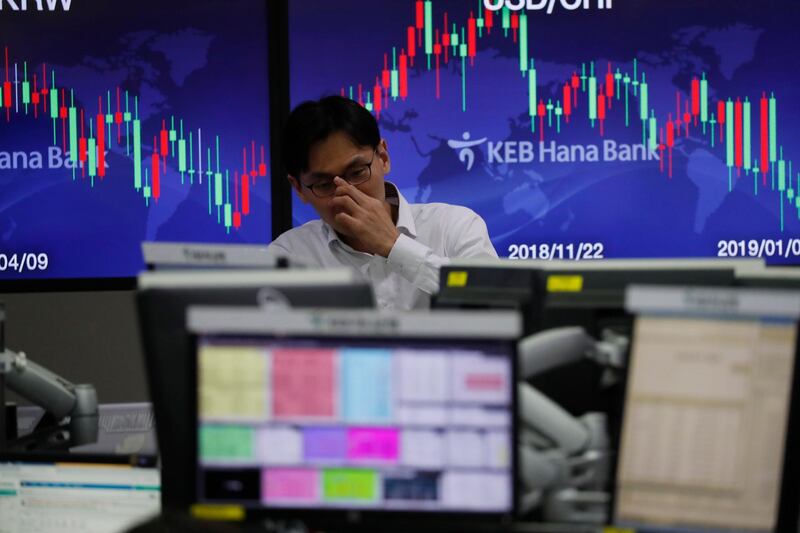As the great unwind of global monetary stimulus gains momentum, markets are at increased risk of experiencing "doom loops". Investors need to be prepared for these downward spirals, where shocks set off a self-perpetuating sequence of disruptions.
There are five doom loops that feed each other in a financial crisis.
The collateral doom loop
Declines in the value of stocks, bonds, property or derivatives tied to them trigger margin calls. These demands for collateral absorb cash or necessitate liquidation of assets, transmitting the pressure even to previously unaffected securities. Stresses are magnified where liquidity is constrained, causing further falls. Losses, reduced capital buffers and tightened liquidity results. The cycle repeats until a price equilibrium is reached.
The hedging doom loop
Sliding asset values cause investors to hedge by short-selling or buying put options as insurance. When market conditions are volatile or where traders cannot buy or sell the underlying asset, they resort to proxies such as different securities, currencies or commodities. This creates contagion. Declines force additional selling by banks seeking to hedge their exposure to options they have sold. For example, recent falls in oil prices were exacerbated by intermediaries covering put options purchased by US shale oil producers. This intensifies price pressures and absorbs trading market capacity.
The sovereign doom loop
Changes in sovereign risk set in train negative price spirals because of the linkages between governments, central banks and commercial lenders, accelerating the crisis.
Since 2007, bank purchases of government securities have increased. This reflects regulatory requirements for higher liquidity reserves. Banks boosted holdings to post as collateral for their exposure to derivative transactions. Meanwhile, quantitative easing programs encouraged institutions to borrow cheaply from central banks and invest in government bonds with higher returns. Bank regulations treat government debt as substantially risk free and don’t require capital to be held against holdings, increasing returns on equity. The downside is that when rates increase, and debt prices fall, banks suffer losses. Government support may be needed to safeguard solvency and ensure operating viability, increasing stresses on the sovereign.
This problem is especially important in Europe. Italian banks hold nearly $457 billion of domestic sovereign debt (10 per cent of their total assets). Potential exposures are larger than the shareholders’ funds of some Italian lenders. Recent rises in the yield on Italian government bonds – reflecting higher-than-anticipated budget deficits, the end of the European Central Bank’s QE programme and domestic political instability – have increased the problems of financial institutions already laden with significant nonperforming loans.
The sovereign doom loop also affects central banks with large holdings of government bonds purchased as part of QE programs. When U.S. Treasury rates rose sharply in 2013 during the so-called taper tantrum, the Federal Reserve under then-Chairman Ben Bernanke had unrealised mark-to-market losses of more than $50bn on its securities portfolio. Stress tests applied to banks suggested that the Fed could face losses estimated at between $200bn and $400bn. While central banks cannot technically go bankrupt, losses that reduce or wipe out capital reduce confidence in the currency and increase sovereign risk. This may make it difficult for a central bank to exercise its functions and support the financial system.
_______________
Read more:
Europe will also suffer from a no-deal Brexit
Will Fed pause? Will ECB hike? Will trade war thaw?: Economy Q&A
_______________
The intermediary doom loop
Banks help propagate feedback loops. Disruptions absorb liquidity and reduce credit availability. One bank’s weakness fans concerns about other domestic and foreign institutions exposed to the entity. Sovereign risk rises as markets assume governments underwriting of the financial system. This initiates a continuous cycle of rising bank risk fueling increases in sovereign risk.
Declines in interbank lending and trading constrain liquidity. Financial system instability increases as traders reduce dealings with each other, conserving capital and cash. Banks use conservative mark-to-market prices, aggravating price declines and triggering margin calls. More stringent counterparty risk management reduces credit limits and requires additional security, feeding into the collateral doom loop. Hedging of counterparty risk exacerbates liquidity and price stresses. Losses increase and liquidity contracts.
The need for yield and the recovery of share prices have attracted a new generation of investors in bank shares who are ignoring the lessons of 2008. Losses could force banks to cut dividends. This reduces investor income and may spark sharp sell-offs, hampering banks’ ability to raise new capital and deepening the crisis. Such a dynamic also fuels the sovereign, collateral and hedging doom loops.
The real economy doom loop
Constrained bank lending creates tighter credit conditions and higher costs, which affects indebted or cash-flow-constrained businesses and households. Balance-sheet pressure leads to defaults and bankruptcies as well as fire sales of assets to repay maturing debt or meet obligations. Cash-flow pressures curtail consumption and investment, forcing deleveraging and causing economic activity to slow, further weakening conditions. There are successive cycles of losses, tightening of credit and falls in liquidity. Concern about need for government support for the banking system feeds rising sovereign risk.
Given the reduced arsenal of available policy tools, increased market scepticism about economic policy and a dysfunctional political environment, authorities could find it difficult to break these feedback cycles. In 2019, capital preservation will require investors to anticipate and navigate these doom loops.






